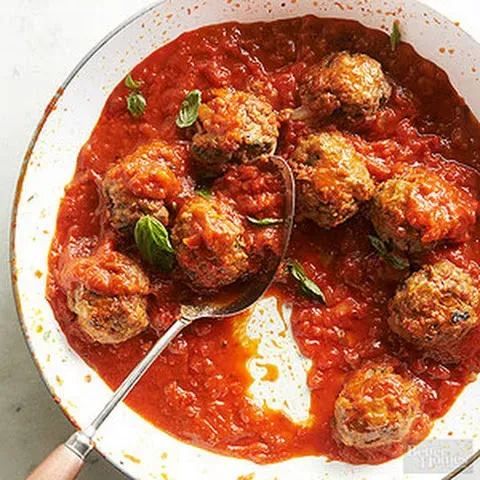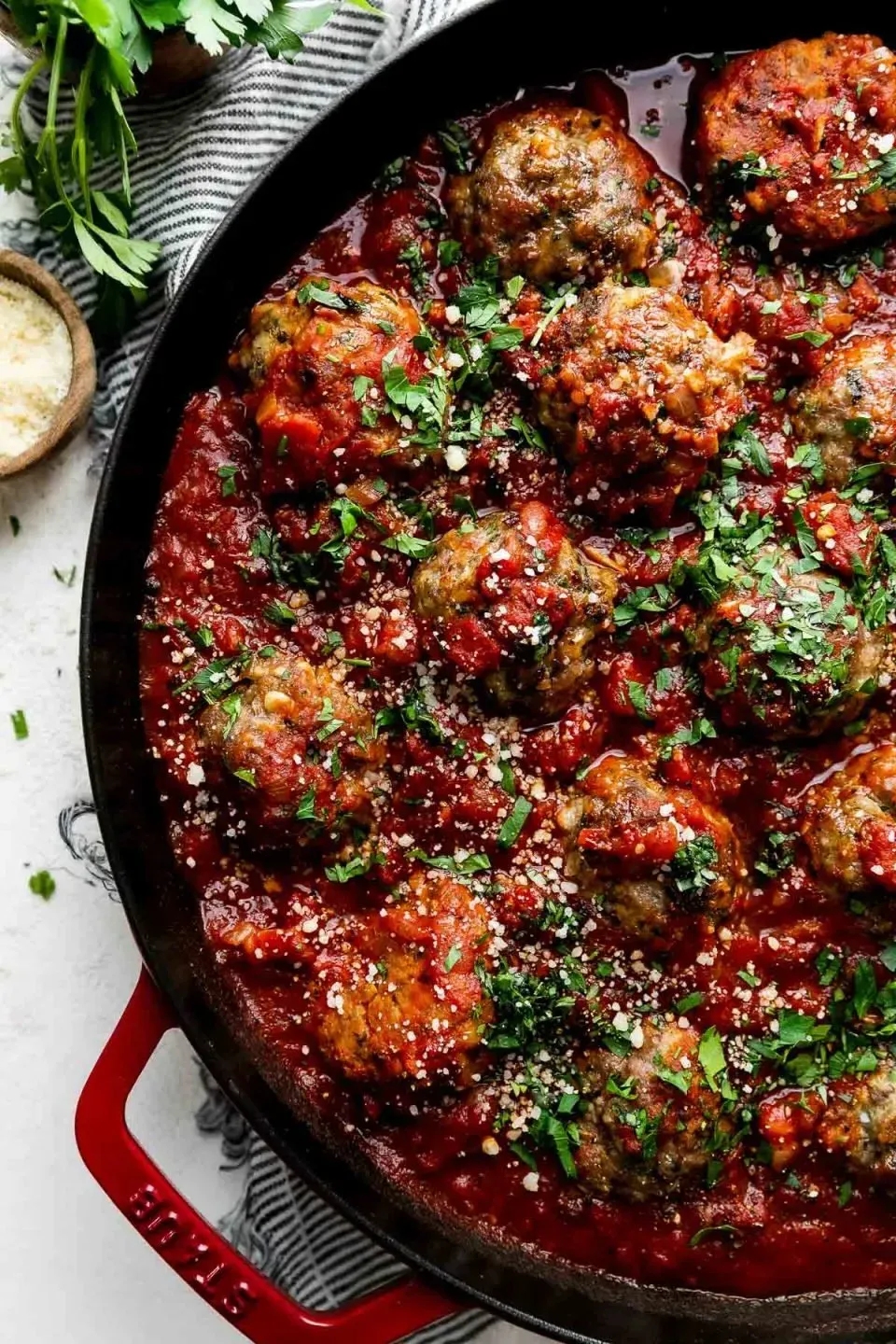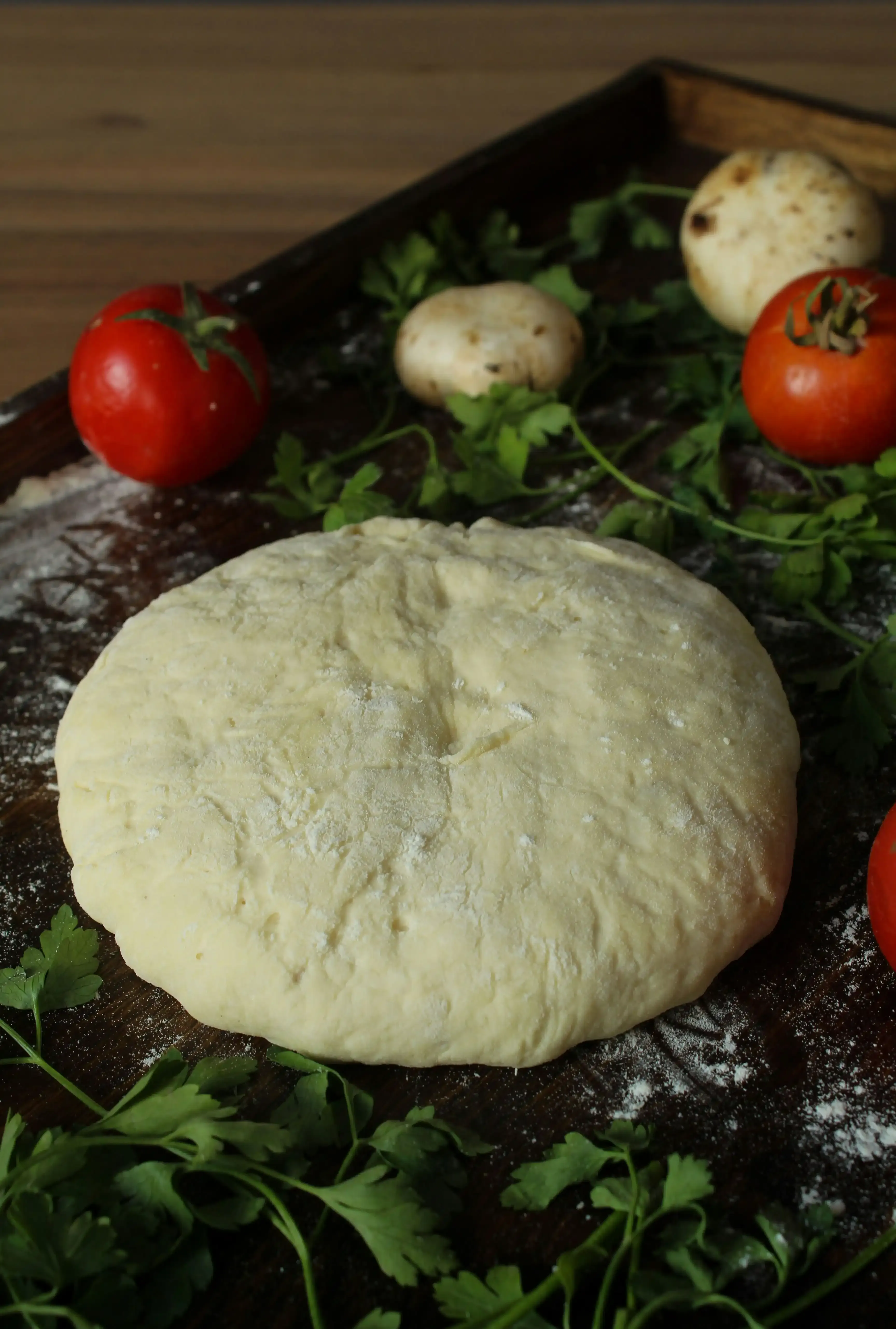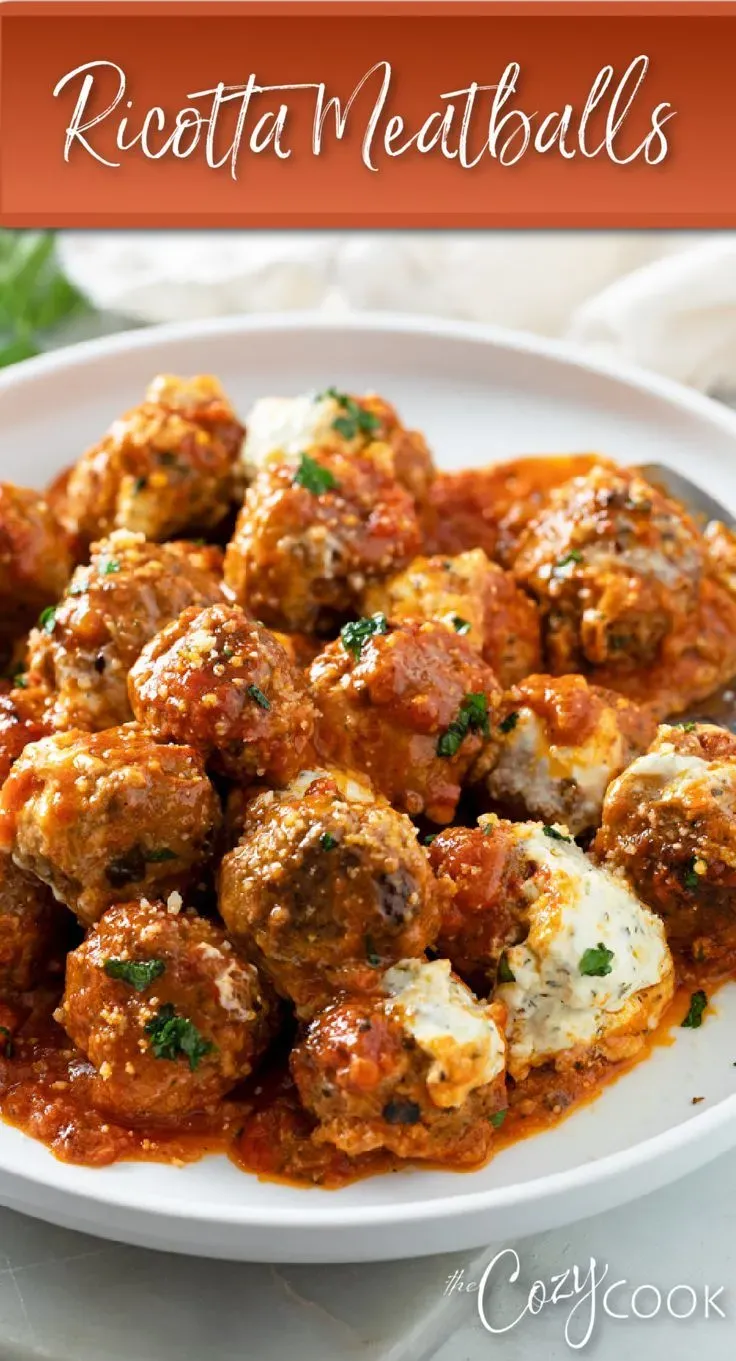Are your meatballs usually dense little rocks? Do they taste okay, but lack that melt-in-your-mouth tenderness you crave? It's a common complaint in the meatball world, a source of quiet disappointment at dinner tables everywhere. Most folks just mix meat, breadcrumbs, and egg and call it a day. That's fine, if "fine" is the culinary mountain you're aiming to climb. But if you want meatballs that are truly next-level, the kind that disappear from the plate before you even sit down, there's a simple, often overlooked trick. The secret ingredient that makes all the difference? Ricotta cheese. Adding ricotta doesn't just add flavor; it infuses the meatballs with an incredible lightness and moisture, creating a texture that's impossible to achieve with just meat and bread. Forget dry, forget tough, forget boring. We're talking tender, juicy perfection, meatballs that practically melt on your tongue. This isn't just any recipe; we're unlocking the secrets to the best italian meatball recipe with ricotta cheese. We'll guide you through selecting the right blend of meats and cheeses, the simple technique for mixing without overworking, and the best ways to cook them for optimal results. We'll also tackle common pitfalls and offer variations to keep things interesting. Get ready to transform your meatball game and impress everyone at the table.
Why Ricotta Makes the Best Italian Meatballs

Why Ricotta Makes the Best Italian Meatballs
Let's be honest, nobody wants a meatball that feels like a hockey puck. You bite into it, and it's dry, crumbly, maybe even a little tough. That's where ricotta cheese steps in, like a culinary superhero for sad, dense meatballs. It's not just an optional extra; it's the secret weapon for achieving that cloud-like tenderness everyone raves about. Ricotta, with its creamy texture and high moisture content, melts as the meatballs cook, distributing moisture throughout the mixture. This prevents the meat from drying out and creates tiny pockets of air and creaminess, resulting in a light, incredibly juicy meatball. It binds everything together gently without making things heavy, a common pitfall with just breadcrumbs and egg. This simple addition is precisely why you get the best Italian meatball recipe with ricotta cheese – a game-changer for texture and flavor.
Gathering Ingredients for Your Best Italian Meatball Recipe

Gathering Ingredients for Your Best Italian Meatball Recipe
Alright, so you're convinced ricotta is the secret sauce (pun intended) to tender meatballs. Now, let's talk groceries. You can't make a silk purse out of a sow's ear, as my nonna used to say, and the same goes for meatballs. Quality ingredients are non-negotiable if you want the best italian meatball recipe with ricotta cheese. You'll need a mix of meats for depth of flavor – typically beef, pork, and sometimes veal. Don't skimp on the fat content; that helps with moisture. Fresh ricotta is key here, not the watery stuff. Look for whole milk ricotta, ideally from a local deli or cheese shop if possible. Beyond the proteins and star cheese, you'll need fresh breadcrumbs (not dried!), eggs to bind, grated Parmesan or Pecorino Romano for that salty tang, fresh parsley, garlic, and maybe a pinch of nutmeg like some old-school recipes call for. Think fresh, vibrant, and high-quality – your meatballs will thank you.
- Ground Beef (80/20 or 85/15 fat ratio)
- Ground Pork
- Whole Milk Ricotta Cheese
- Fresh Breadcrumbs (made from stale bread)
- Eggs
- Grated Parmesan or Pecorino Romano Cheese
- Fresh Italian Parsley, chopped
- Garlic, minced
- Salt and Freshly Ground Black Pepper
- Optional: A pinch of nutmeg
Crafting and Cooking Your Ricotta Cheese Meatballs

Crafting and Cooking Your Ricotta Cheese Meatballs
Mixing Your Meatball Magic (Gently!)
Alright, you've got your gorgeous pile of ingredients ready to go. Now comes the crucial step: mixing. This isn't a wrestling match; it's more like a gentle waltz. Dump everything into a large bowl – the ground meats, that lovely ricotta, the breadcrumbs, eggs, cheeses, herbs, garlic, salt, pepper, maybe that pinch of nutmeg. Now, here's where most people mess up: they go in like they're kneading bread dough. Don't do it. Overmixing is the express train to tough, dense meatballs. You want to mix just until everything is *just* combined. Use your hands, but be light. Imagine you're fluffing clouds, not building a brick wall. The goal is to distribute the ingredients evenly without compressing the mixture. This gentle touch is foundational to achieving the tender texture that defines the best italian meatball recipe with ricotta cheese.
Once mixed, it's time to form the balls. Size matters here, but personal preference plays a role too. Some like golf ball size, others prefer something closer to a small baseball. Whatever you choose, try to make them relatively uniform so they cook evenly. Don't pack them super tight; a light touch is still your friend. A small ice cream scoop can help with consistency if you're feeling fancy. Place the formed meatballs on a baking sheet lined with parchment paper as you go. Pop them in the fridge for 15-20 minutes while you get your sauce ready or heat your pan. This helps them hold their shape better when they hit the heat.
Here’s a quick checklist for mixing success:
- Combine all ingredients in a large bowl.
- Use your hands for the best feel.
- Mix gently until *just* combined – no overworking.
- Form balls of uniform size, don't pack them tightly.
- Chill briefly before cooking.
Cooking Methods for Tender Ricotta Meatballs
Now for the cooking. There are two classic paths to meatball nirvana: browning and simmering, or baking and simmering. Browning them in a pan first gives them a lovely crust and deepens the flavor significantly. Heat a good amount of olive oil (or a mix of oil and butter) in a large, heavy skillet over medium-high heat. Carefully add the meatballs, working in batches if necessary to avoid crowding the pan. You want a nice sear on all sides, about 5-7 minutes total. They won't be cooked through, and that's okay. This step isn't strictly necessary if you're in a rush, but it adds a layer of complexity that's hard to beat.
After browning (or if you skipped browning), the meatballs finish cooking by simmering gently in your favorite marinara or tomato sauce. Slide the browned meatballs directly into the simmering sauce. If you skipped browning, gently place the raw meatballs into the sauce. Cover the pot and let them simmer for at least 30 minutes, or even longer – up to a couple of hours won't hurt, just adds more flavor. This low, slow cook in the sauce is where the magic happens for ricotta meatballs. The sauce keeps them moist, and the ricotta does its tenderizing work. They absorb the flavors of the sauce, becoming incredibly rich and succulent. This is the secret to getting that perfect texture from your best italian meatball recipe with ricotta cheese.
Which method is best for you?
Method | Pros | Cons |
|---|---|---|
Pan Browning then Simmering | Deep flavor, nice crust, traditional method | More hands-on, potential for splattering grease |
Baking then Simmering | Less messy, can cook more at once | Slightly less developed crust/flavor than browning |
Simmering from Raw | Simplest, one-pot method | Less flavor development, can be more fragile |
Serving and Variations for Your Best Meatballs

Serving and Variations for Your Best Meatballs
Classic Pairings and Serving Suggestions
you've put in the work, the kitchen smells amazing, and those ricotta meatballs are swimming in a beautiful pool of sauce. Now, how do you serve these little clouds of deliciousness? The absolute classic, of course, is over a heaping pile of spaghetti. There's a reason it's iconic – the sauce clings perfectly to the pasta, and each bite is a delightful mix of noodle, sauce, and tender meatball. Make sure you use a good quality pasta and cook it al dente. Don't just dump the meatballs on top; toss the pasta with some of the sauce first, then nestle the meatballs in. Garnish with more grated cheese and some fresh basil if you have it. It's simple, comforting, and highlights why you made the best italian meatball recipe with ricotta cheese in the first place.
But spaghetti isn't the only game in town. These meatballs are versatile. Try them in a crusty sub roll for an epic meatball sub, layered with provolone or mozzarella and baked until gooey. Serve them as an appetizer, perhaps with toothpicks, or alongside some crusty bread for dipping in the sauce. They're fantastic over creamy polenta or even mashed potatoes for a different kind of comfort food. Don't be afraid to think beyond the pasta bowl; these tender ricotta meatballs can elevate pretty much anything they touch.
Getting Creative: Easy Meatball Recipe Variations
Once you've mastered the basic best italian meatball recipe with ricotta cheese, you might feel adventurous. Good! This recipe is a fantastic base for experimentation. Want to switch up the meat? Try adding some ground turkey or chicken for a lighter version, though you might lose a little richness. Just be careful not to dry them out. You can play with the herbs too – add some fresh oregano, thyme, or even a pinch of red pepper flakes for a little heat. Some recipes call for soaking bread in milk instead of using dry breadcrumbs; this can add even more moisture. If you prefer baking to browning, you can bake them on a parchment-lined sheet at around 375°F (190°C) for about 15-20 minutes until lightly browned, then transfer them to the sauce to finish.
Another simple variation is to add finely chopped sautéed onions or bell peppers to the mix before forming the meatballs. Just make sure they're cooked and cooled so they don't add excess moisture. You can also experiment with different types of cheese – a mix of Parmesan and Pecorino is classic, but a little shredded mozzarella in the mix can make them extra gooey inside. The key is to maintain that crucial ratio of meat to binder (breadcrumbs, egg, ricotta) to keep them tender. Don't go crazy adding too many wet ingredients, or they won't hold their shape.
- Try different meat blends (add turkey or veal).
- Experiment with herbs (oregano, thyme, red pepper flakes).
- Soak bread in milk instead of using dry breadcrumbs.
- Add finely chopped sautéed vegetables (onions, peppers).
- Mix in different cheeses (mozzarella).
- Bake instead of browning for less mess.
Troubleshooting Common Ricotta Meatball Questions

Troubleshooting Common Ricotta Meatball Questions
so you've got the recipe down, you're mixing gently, and you're cooking them right. But maybe something still feels... off. Don't sweat it; even with the best italian meatball recipe with ricotta cheese, little hiccups can happen. The most common complaint I hear is, "Why are my meatballs still tough?" Usually, that circles back to overmixing. You really just want to coax the ingredients together, not beat them into submission. Another issue is meatballs falling apart. This can sometimes happen if your ricotta is too wet (drain it first!) or if you didn't use enough binder (eggs or breadcrumbs). Or perhaps you didn't chill them briefly before cooking, which helps them firm up. Sometimes, people try to flip them too early when browning, before they've developed a crust. Patience, young grasshopper. Giving them space in the pan and letting them sear properly helps them hold together. It's a bit of a balancing act, but once you get the feel for the right consistency and mixing technique, you're golden.
Here are a few common issues and quick fixes:
- Meatballs are tough: You probably overmixed. Be gentler next time.
- Meatballs fall apart: Ricotta might be too wet (drain it), not enough binder (check egg/breadcrumb amounts), or not chilled long enough.
- Meatballs are dry: Used too lean meat, didn't simmer long enough in sauce, or cooked at too high heat.
Your Tender Meatball Triumph
So there you have it. No more dense, rubbery disappointments masquerading as meatballs. By incorporating ricotta cheese, you've unlocked a simple yet profound secret to achieving that coveted tender texture and rich flavor. It's not magic; it's just smart cooking, leveraging the moisture and richness of the cheese. You've got the steps, the tips, and the understanding of why this approach simply works better. Go forth and make meatballs that actually earn their place on the plate, whether nestled in sauce or piled high on a hero roll. The bar has officially been raised.